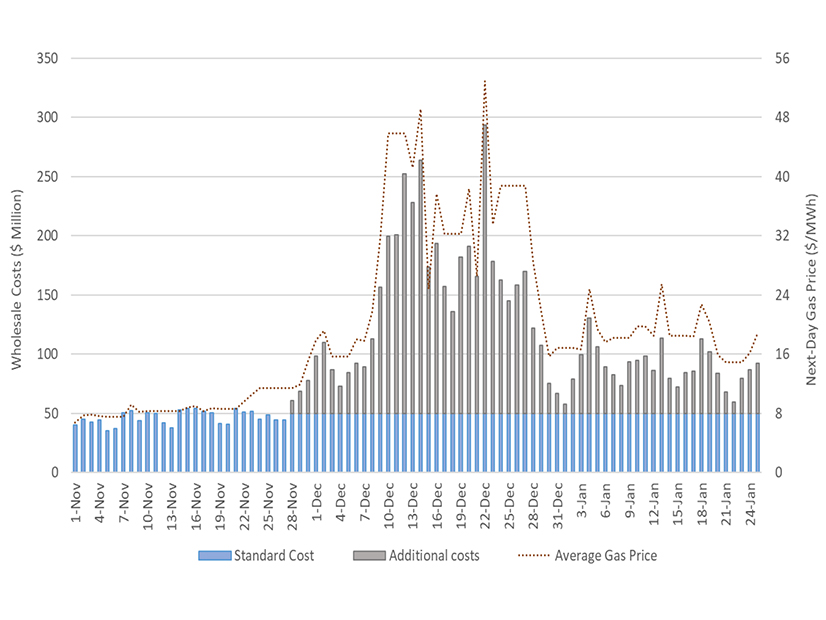
Soaring natural gas prices drove up wholesale electricity costs in the CAISO energy market by roughly $4 billion in December and January, making it one of the more expensive periods in recent years, an ISO report said this week.
About $3 billion of that amount came in December, when natural gas prices in California far outpaced the national benchmark Henry Hub in Louisiana. On Dec. 21, for example, spot prices at Henry Hub averaged $6.14/MMBtu, while those in California reached $53.59/MMBtu, nearly nine times more, the U.S. Energy Information Agency reported.
High natural gas prices impacted large swaths of the West in December, including the Desert Southwest and the Pacific Northwest.
“Next-day natural gas prices for Western hubs reached a maximum value of about $57/MMBtu on Dec. 22,” a day when CAISO’s wholesale costs surged toward $300 million, far beyond its standard cost of $50 million, the CAISO report said.
“Prices for other Western hubs traded at similarly elevated levels across the month of December … [while] Henry Hub prices remained comparatively low,” it said.
In the fourth quarter of 2022, total electricity costs in CAISO reached $7.4 billion, just short of the third quarter’s $7.6 billion total during a severe heat wave that brought CAISO to the verge of ordering rolling blackouts Sept. 6 and pushed electricity prices past $2,000/MWh. (See CAISO Reports on Summer Heat Wave Performance.)
The third quarter costs reflected “summer conditions where record-high demand levels were settled at relatively higher prices given the tight supply conditions,” the report said. “The cost of fourth quarter of 2022 came fairly close to the same level of the third quarter, at about $7.4 billion, even though electric demand was lower.”
“This is a twofold and threefold increase relative to the fourth quarters of 2021 and 2020, respectively,” it said.
The sudden and largely unexplained jump in energy prices in California and the West led Gov. Gavin Newsom to urge FERC to act. In a letter Monday to FERC Chair Willie Phillips, Newsom asked the commission to “immediately focus its investigatory resources on assessing whether market manipulation, anticompetitive behavior or other anomalous activities are driving these ongoing elevated prices in the Western gas markets.”
Wholesale natural gas prices directly affect electricity costs because California relies heavily on gas-fired power plants, which often act as the marginal unit setting the price for all units clearing CAISO’s day-ahead and real-time markets. The gas costs are passed on to ratepayers by the state’s investor-owned utilities, doubling and tripling bills for millions of customers, especially in Southern California.
“California’s residential customers are, consequentially, suffering the economic burden of extreme and unexpectedly high gas and electric utility bills,” Newsom wrote.
The California Public Utilities Commission, state Energy Commission and CAISO held a joint meeting Tuesday to try to understand the factors that led to the extraordinary price hikes. Market analysts and utilities weighed in, citing conditions such as an El Paso Natural Gas pipeline that exploded in Arizona in August 2021, impacting one supply line to California, and CPUC limits on storage at Southern California Gas Company’s Aliso Canyon, where a massive methane leak occurred in October 2015.
A cold snap in December increased heating demand from residential customers in California and across the West, panelists said.
In his letter to FERC, Newsom said the cold weather certainly “exacerbated” the gas price increases but lower-than-normal temperatures and other “known factors cannot explain the extent and longevity of the price spike,” which began in late November and lasted through January.
“It is clear that the root causes of these extraordinary prices warrant further examination,” he said.

